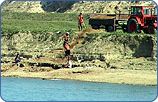 |
The whole Danube river basin has an important fraction of the world’s agricultural resources, agriculture having a long and well-known tradition. Fertile areas along the middle and lower parts of the Danube rank among the most important agricultural regions in Europe. Agriculture, a traditionally prominent branch of economy, covers different activities, including crop production, livestock, fish farming and forest management. Intensification of land use was made possible through conversion of large parts of wetlands. Except for Germany and Austria, the countries of the Danube basin entered transition in 1989-1990 with a common heritage in agriculture: exceptionally large cooperative-size state-owned farms and collective production. Unfortunately, this farming system, known as "conventional farming", has produced progressive social and economic results on the one hand and serious environmental damage on the other, mainly on water and soil, the countries’ vital resources, and consequently on bio-diversity as the genetic basis, and on human health. The main problems caused by agricultural activities in all the countries of the Danube basin are due to the inappropriate use of fertilizers and pesticides causing alteration in the nitrogen balance and an increase of pesticides in soil and water. If the potential synergetic effects are considered, there are several pieces of evidence testifying to the irrational and uncontrolled use of land resources, with considerable anthropogenic pressure, which calls for an essential improvement of the land management system. The main polluters include large animal husbandry units, crop and fruit-tree farms, mechanical companies, and agricultural land and forest units. Disposal of animal waste on platforms or drying beds with inappropriate or no treatment (mainly at pig farms, which generate large volumes of wastewater) has prevented it from being reintroduced in the natural energy cycle through fertilization in the field and has resulted in its disposal beyond the safety capacities or ? more seriously - in the drainage canals, from which it reaches the emissary. The inappropriate land use, together with extensive deforestation, has led to soil erosion. The main activities contributing to water pollution include inappropriate land and water resources management (large-scale production farming, improper inland water management, environmentally unfriendly exploitation of forests, inappropriate wetlands management, inefficient flood prevention and control hydraulic structures; elimination of buffering and self-purification elements; soil erosion); improper fish farm management (fish farming through inadequate use of piscicol ponds); inadequate use of pesticides and fertilizers (plant cultivation, viticulture, fruit growing); inadequate treatment of animal farm wastes (unsuitable manure disposal, improper storage of wastes from livestock farming, discharge of liquid waste without pre-treatment); transport through waste oil from agricultural machinery; the war effects and the changes in ownership and the economic conditions. The recently-developed private agricultural sector is very fragile, without sufficient support and laden with innumerable obstacles, which has resulted in substantial positive economic changes, benefiting the new owners, and in stopping or even decreasing pollution of water and soil as natural resources. This paradox is explained by the decrease in the amount of fertilizers and pesticides used in agriculture as a consequence of their excessive prices as compared to the financial power of the new farmers, as well as by quite frequent subsistence farming. The goals of the sector policies aim to permanently reduce the use of agrochemical, reduce soil erosion and ensure effective management of manure from intensive animal farms. The awareness raising campaign and training of the farmers focus on good agricultural practices, ways to reduce erosion from agricultural land and the reduction in pollution from large pig farms by adopting innovative technologies and using nutrient rich manure as fertilizers. |






